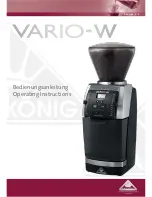
18
creamy appearance and increasing its volume. To obtain
creamier foam, immerse the milk-frother in the milk and
move the container slowly upwards.
8. When the volume of the milk has doubled, immerse the
milk-frother fully and continue to heat the milk. When the
required temperature is reached (ideally 60°), together
with the right density of cream, cut off the steam supply
by turning the steam knob in a clockwise direction until it
stops, and rotating the selector to position . To turn
off the machine, turn the selector knob to position e .
9. Pour the emulsified milk into the cups containing the pre-
viously prepared espresso coffee. The cappuccino is now
ready. Add sugar to taste and, if desired, sprinkle a little
chocolate powder on the froth.
Take note:
• If you want to prepare more than one cappuccino, make
all the espresso coffees together in advance and only then
prepare the whipped cream for all the cappuccinos.
• If you want to prepare some more coffee after whipping
up the milk, wait until the boiler cools down, because
otherwise the coffee will come out burnt.
To cool down the boiler, put a container under the boiler
nozzle; turn the selector knob to
(fig. 16); let the wa-
ter escape until the “OK” light goes out; turn the selector
knob back to and prepare the coffee as described in
the preceding paragraphs.
• You are advised not to let the steam come out for more
than 60 seconds, and not to froth up the milk more than 3
times consecutively.
Caution:
For reasons of hygiene you are recommended to always clean
the milk-frother after use. Proceed in the following manner:
1. Allow a little steam to escape for a few seconds (see
points 2, 5, and 6 of the preceding paragraph) by turning
the steam knob (fig. 25). In this way, the milk-frother will
flush out milk that may have remained inside it. Turn off
the appliance by pressing the on/off button.
2. Grip the tube of the milk-frother firmly with one hand,
and with the other, release the milk-frother itself by tur-
ning it in a clockwise direction and unscrewing it down-
wards (fig. 26).
3. Remove the steam nozzle from the supply tube by pulling
it downwards.
4. Wash the milk-frother and the steam nozzle thoroughly in
warm water.
5. Check that the two holes indicated by arrows in fig. 27 are
not blocked. If necessary, clean them out with a pin.
6. Replace the steam nozzle, pushing it upwards quite force-
fully into the steam tube.
7. Re-mount the milk-frother by screwing it upwards in an
anti-clockwise direction.
Production of hot water
1. Switch on the machine by turning the selector knob to po-
sition (the relative light will come on) (fig. 12). Wait
until the OK light shows (fig. 15).
2. Position a receptacle under the milk-frother.
3. When the OK light comes on, position the selec-
tor knob at
(fig. 16), simultaneously turning
the steam knob in an anti-clockwise direction (fig.
25): hot water will come out of the milk-frother.
4. To stop the flow of hot water, turn the steam knob in a
clockwise direction and turn the selector knob to
(fig. 12).
A maximum output of 60 seconds is advisable.
Cleaning
Danger!
• During the cleaning operation, never immerse the machi-
ne in water. It is an electrical appliance.
• Before carrying out any cleaning of the external parts of
the appliance, switch off the machine, remove the plug
from the power socket and let the machine cool down.
Cleaning and maintenance of the espresso coffee fil-
ters
After every 300 coffees, or when the coffee comes out of the
filter-holder in drops or fails to come out completely, clean the
filter-holder and the filters in the following manner:
• Remove the filter from the filter-holder.
• Undo the top of the filter (fig. 28), unscrewing it in the
direction indicated on the top itself.
• Remove the frothing device from the container by pu-
shing it off the top part.
• Take out the washer.
• Rinse all the components and clean the metal filter tho-
roughly with hot water, scrubbing it with a brush (fig. 29).
Check that the small holes in the filter are no blocked and,
if necessary, clean them out with a pin (see fig. 30).
• Replace the filter and the washer on the plastic disc, as
shown in fig. 31. Take care to insert the pin of the plastic
Production of hot water - Cleaning


























